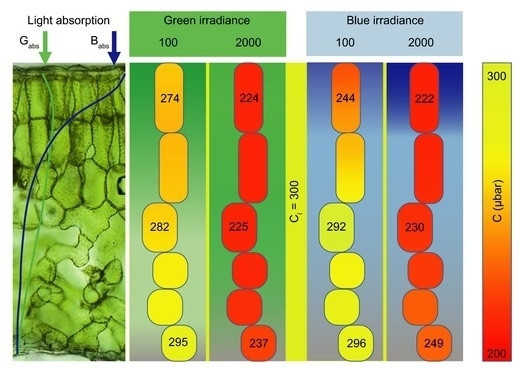During the process of photosynthesis, leaves trap the atmospheric carbon dioxide (CO2) and convert it into organic compounds. But getting the CO2 from the surface of the leaf to the enzymes where carbon is stored within the leaves presents several challenges.

Image Credit: John Evans and Natalia Bateman.
Interpreting how each of the numerous barriers faced by CO2 molecules in their frantic quest for fixation is very crucial, if one wants to exploit these molecules and increase crop production.
In a Tansley review recently published in the New Phytologist journal, Professor John Evans from the ARC Centre of Excellence for Translational Photosynthesis assessed the literature reported on the conductance of mesophyll cells in leaves and developed a “leaf profile” of the various components involved in the CO2 journey within the leaf and their relative significance.
We need to know what is the relative importance of features such as the surface area of mesophyll cells, the thickness of the cell wall and the permeability of the membranes within the cell, to determine how easy it is for carbon dioxide to move to the sites of fixation.”
John Evans, Study Author and Professor, Research School of Biology, Australian National University
Professor Evans continued, “Carbon dioxide consumed during photosynthesis is replaced by diffusion, but this is restricted by stomata and the mesophyll tissues inside the leaf. These restrictions influence how much water and nitrogen are required to fix carbon.”
He identified four major questions associated with the cell wall and cell membrane characteristics where research efforts have to be focused. One of them is associated with the type of photosynthesis used by plants.
In C4 plants, like sugarcane, like sugar cane and maize, carbon dioxide only has to reach the cytoplasm, whereas in C3 plants like wheat and rice, there is an additional hurdle moving into the chloroplast which effectively doubles the resistance.”
John Evans, Study Author and Professor, Research School of Biology, Australian National University
Within C3 plants, there are plenty of differences related to the extent of a thickness of the cell walls. Cell walls denote less than a quarter of the overall resistance in crop plants, such as rice which have thin walls; however, they are responsible for over three-quarters of the overall resistance in C3 plants that grow more slowly and have thicker and less porous walls.
Another query targets at stomata—the unlimited number of mouths that cover leaves and enable CO2 and water in and out of each leaf. Stomata can close and open to alter the resistance to water and CO2 exchange.
The resistance linked to the mesophyll cells has also been found to alter when there is a variation in light, temperature, or CO2 concentration. This indicates that the conductance of mesophyll cells is also dynamic. But a few of these dynamic changes may be the result of spatial complexity and not rapid changes in, for instance, membrane permeability.
The article also emphasized an interesting field of research on the function of CO2 permeable aquaporins, an extremely diverse type of “filter” integrated inside cell membranes, that regulate CO2 transport. Aquaporins are being intensely studied since they are a promising engineering target to improve the efficiency of photosynthesis.
Source:
Journal reference:
Evans, J. R., et al. (2020) Mesophyll conductance: walls, membranes and spatial complexity. New Phytologist. doi.org/10.1111/nph.16968.